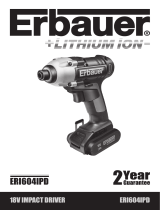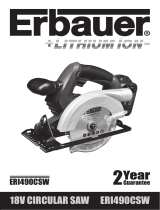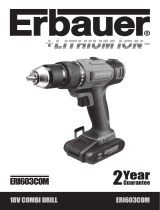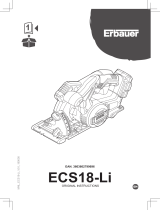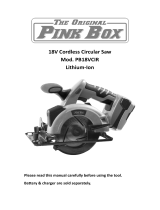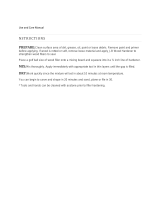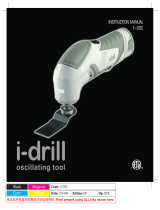Page is loading ...

18V MULTI TOOL ERI616HTL
ERI616HTL

Original Instructions
(Version 3.0)

18V MULTI TOOL ERI616HTL
GUARANTEE
This product carries a 2 year guarantee. If your product develops a fault within this
period, you should in the rst instance contact the retailer where the item was purchased.
This guarantee specically excludes losses caused due to:
- Fair wear and tear
- Misuse or abuse
- Lack of routine maintenance
- Failure of consumable items (such as batteries)
- Accidental damage
- Cosmetic damage
- Failure to follow manufacturer’s guidelines
- Loss of use of the goods
This guarantee does not affect your statutory rights. This guarantee is only valid in the UK.
For further technical advice, spare parts or repair service (outside of guarantee) please con-
tact the customer helpline number on 0345 607 6380.
Congratulations on your purchase of a quality power tool from Erbauer (UK) Ltd. This
product should give you reliable service but for your peace of mind this
power tool does carry a 2 year guarantee, the terms of which are detailed below.
If this product develops a fault within the guarantee period contact your retailer.
Please retain this handbook in case you need to refer to safety, care or guarantee
information in the future.

GENERAL POWER TOOL SAFETY WARNINGS
Warning Read all safety warnings and all instructions.
Failure to follow the warnings and instructions may result in
electric shock, re and/or serious injury.
Save all warnings and instructions for future reference.
The term “power tool” in the warnings refers to your mains-operated
(corded) power tool or battery-operated (cordless) power tool.
1) Work area safety
a) Keep work area clean and well lit. Cluttered or dark areas
invite accidents.
b) Do not operate power tools in explosive atmospheres,
such as in the presence of ammable liquids, gases or
dust. Power tools create sparks which may ignite the dust or
fumes.
c) Keep children and bystanders away while operating a
power tool. Distractions can cause you to lose control.
2) Electrical safety
a) Power tool plugs must match the outlet. Never modify
the plug in any way. Do not use any adapter plugs with
earthed (grounded) power tools. Unmodied plugs and
matching outlets will reduce risk of electric shock.
b) Avoid body contact with earthed or grounded surfaces,
such as pipes, radiators, ranges and refrigerators. There
is an increased risk of electric shock if your body is earthed or
grounded.
c) Do not expose power tools to rain or wet conditions.
Water entering a power tool will increase the risk of electric
shock.
d) Do not abuse the cord. Never use the cord for carrying,
pulling or unplugging the power tool. Keep cord away
from heat, oil, sharp edges or moving parts. Damaged or
entangled cords increase the risk of electric shock.
e) When operating a power tool outdoors, use an extension
cord suitable for outdoor use. Use of a cord suitable for
outdoor use reduces the risk of electric shock.

18V MULTI TOOL ERI616HTL
f)
If operating a power tool in a damp location is
unavoidable, use a residual current device (RCD) protected
supply. Use of an RCD reduces the risk of electric shock.
3) Personal safety
a) Stay alert, watch what you are doing and use common
sense when operating a power tool. Do not use a power
tool while you are tired or under the inuence of drugs,
alcohol or medication. A moment of inattention while operating
power tools may result in serious personal injury.
b) Use personal protective equipment. Always wear eye
protection. Protective equipment such as dust mask, non-skid
safety shoes, hard hat, or hearing protection used for appropriate
conditions will reduce personal injuries.
c) Prevent unintentional starting. Ensure the switch is in
the off-position before connecting to power source and/or
battery pack, picking up or carrying the tool. Carrying power
tools with your nger on the switch or energising power tools that
have the switch on invites accidents.
d
) Remove any adjusting key or wrench before turning the
power tool on. A wrench or a key left attached to a rotating part
of the power tool may result in personal injury.
e) Do not overreach. Keep proper footing and balance
at all times. This enables better control of the power tool in
unexpected situations.
f) Dress properly. Do not wear loose clothing or jewellery.
Keep your hair, clothing and gloves away from moving
parts. Loose clothes, jewellery or long hair can be caught in
moving parts.
g) If devices are provided for the connection of dust
extraction and collection facilities, ensure these are
connected and properly used. Use of dust collection can
reduce dust-related hazards.
4) Power tool use and care
a) Do not force the power tool. Use the correct power tool
for your application. The correct power tool will do the job
better and safer at the rate for which it was designed.

b) Do not use the power tool if the switch does not turn
it on and off. Any power tool that cannot be controlled with the
switch is dangerous and must be repaired.
c) Disconnect the plug from the power source and/or
the battery pack from the power tool before making any
adjustments, changing accessories, or storing power tools.
Such preventive safety measures reduce the risk of starting the
power tool accidentally.
d) Store idle power tools out of the reach of children and
do not allow persons unfamiliar with the power tool or
these instructions to operate the power tool. Power tools are
dangerous in the hands of untrained users.
e) Maintain power tools. Check for misalignment or binding
of moving parts, breakage of parts and any other condition
that may affect the power tool’s operation. If damaged,
have the power tool repaired before use. Many accidents are
caused by poorly maintained power tools.
f) Keep cutting tools sharp and clean. Properly maintained
cutting tools with sharp cutting edges are less likely to bind and
are easier to control.
g) Use the power tool, accessories and tool bits etc. in
accordance with these instructions, taking into account the
working conditions and the work to be performed. Use of
the power tool for operations different from those intended could
result in a hazardous situation.
5) Battery tool use and care
a) Recharge only with the charger specied by the
manufacturer. A charger that is suitable for one type of battery
pack may create a risk of re when used with another battery
pack.
b) Use power tools only with specically designated
battery packs. Use of any other battery packs may create a risk
of injury and re.
c) When battery pack is not in use, keep it away from other
metal objects, like paper clips, coins, keys, nails, screws or
other small metal objects, that can make a connection from
one terminal to another. Shorting the battery terminals together

18V MULTI TOOL ERI616HTL
may cause burns or a re.
d) Under abusive conditions, liquid may be ejected from
the battery; avoid contact. If contact accidentally occurs,
ush with water. If liquid contacts eyes,
additionally seek
medical help. Liquid ejected from the battery may cause irritation or
burns.
6) Service
a) Have your power tool serviced by a qualied repair
person using only identical replacement parts. This will
ensure that the safety of the power tool is maintained.
SAFETY INSTRUCTION FOR CUTTING
1. Hold power tool by insulated gripping surfaces, when performing
an operation where the cutting accessory may contact hidden
wiring. Cutting accessory contacting a “live” wire may make
exposed metal parts of the power tool “live” and could give the
operator an electric shock.
2. Always wear a dust mask.
ADDITIONAL SAFETY INSTRUCTIONS FOR YOUR BATTERY
CHARGER
1. This appliance can be used by children aged from 8 years and
above and persons with reduced physical, sensory or mental
capabilities or lack of experience and knowledge if they have
been given supervision or instruction concerning use of the
appliance in a safe way and understand the hazards involved.
Children shall not play with the appliance. Cleaning and user
maintenance shall not be made by children without supervision.
2. If the charger supply cord is damaged, it must be replaced by
the manufacturer, its service agent or similarly qualied persons
in order to avoid a hazard.
3. Before charging, read the instructions.
4. After charging, disconnect the battery charger from the supply
mains. Then remove the chassis connection and then the
battery connection.

5. Do not charge a leaking battery.
6. Do not use chargers for works other than those for which they are
designed.
7. Before charging, ensure your charger is matching the local AC
supply.
8. For indoor use, or do not expose to rain.
7. The charging device must be protected from moisture.
9. Do not use the charging device in the open.
10. Do not short out the contacts of battery or charger.
11. Respect the polarity “+/-“ when charging.
12. Do not open the unit and keep out of the reach of children.
13. Do not charge the batteries of other manufactures or ill-suited
models.
14. Ensure that the connection between the battery charger and
battery is correctly positioned and is not obstructed by foreign
bodies.
15. Keep battery charger’s slots are free of foreign objects and protect
against dirt and humidity. Store in a dry and frost-free place.
16. When charging batteries, ensure that the battery charger is in
a well-ventilated area and away from inammable materials.
Batteries can get hot during charging. Do not overcharge
any batteries. Ensure that batteries and chargers are not left
unsupervised during charging.
17. Do not recharge non-rechargeable batteries, as they can overheat
and break.
18. Longer life and better performance can be obtained if the battery
pack is charged when the air temperature is between 18°C and
24°C. Do not charge the battery pack in air temperatures below
4.5°C, or above 40.5°C. This is important as it can prevent serious
damage to the battery pack.
19. Charge only battery pack of the same model provided by
Manufacturer and of models recommended by the Manufacturer.
SAFETY WARNINGS FOR BATTERY PACK
a) Do not dismantle, open or shred cells or battery pack.
b) Do not short-circuit a battery pack. Do not store battery packs
haphazardly in a box or drawer where they may short-circuit
each other or be short-circuited by conductive materials. When

18V MULTI TOOL ERI616HTL
battery pack is not in use, keep it away from other metal objects,
like paper clips, coins, keys, nails, screws or other small metal
objects, that can make a connection from one terminal to another.
Shorting the battery terminals together may cause burns or a re.
c) Do not expose battery pack to heat or re. Avoid storage in
direct sunlight.
d) Do not subject battery pack to mechanical shock.
e) In the event of battery leaking, do not allow the liquid to
come into contact with the skin or eyes. If contact has been
made, wash the affected area with copious amounts of water and
seek medical advice.
f) Seek medical advice immediately if a cell or battery pack has
been swallowed.
g) Keep battery pack clean and dry.
h) Wipe the battery pack terminals with a clean dry cloth if they
become dirty.
i) Battery pack needs to be charged before use. Always refer to
this instruction and use the correct charging procedure.
j) Do not maintain battery pack on charge when not in use.
k) After extended periods of storage, it may be necessary to
charge and discharge the battery pack several times to
obtain maximum performance.
l) Battery pack gives its best performance when it is operated
at normal room temperature (20°C ± 5°C).
m) When disposing of battery packs, keep battery packs of
different electrochemical systems separate from each other.
n) Recharge only with the charger specied by POSITEC . Do
not use any charger other than that specically provided for
use with the equipment. A charger that is suitable for one type
of battery pack may create a risk of re when used with another
battery pack.
o) Do not use any battery pack which is not designed for use
with the equipment.
p) Keep battery pack out of the reach of children.
q) Retain the original product literature for future reference.
r) Remove the battery from the equipment when not in use.
s) Dispose of properly.
Warning: If a small amount of electrolyte should leak from
the battery pack under extremes of temperature or after

heavy use, then wash off immediately from your skin and hands
using clean water. For eye contact, rinse thoroughly with clean
water and seek medical treatment immediately.
ADDITIONAL SAFETY WARNING FOR CONSTRUCTION DUST
The updated Control of Substances Hazardous to Health Regulations 1st October 2012 now
also targets to reduce the risks associated with silica, wood and gypsum dusts.
Construction workers are one of the at-risk groups within this because of the dust that they
breathe: silica dust is not just a nuisance; it is a real risk to your lungs!
Silica is a natural mineral present in large amounts in things like sand, sandstone and
granite. It is also commonly found in many construction materials such as concrete and
mortar. The silica is broken into very ne dust (also known as Respirable Crystalline Silica or
RCS) during many common tasks such as cutting, drilling and grinding
Breathing in very ne particles of crystalline silica can lead to the development of:
Lung cancer
Silicosis
Chronic Obstructive Pulmonary Disorder (Chronic obstructive pulmonary disease (COPD))
And breathing in ne particles of wood dust can lead to the development of Asthma
The risk of lung disease is linked to people who regularly breathe construction dust over a
period of time, not on the odd occasion.
To protect the lung, the COSHH Regulations sets a limit on the amount of these dusts that
you can breathe (called a Workplace Exposure Limit or WEL) when averaged over a normal
working day. These limits are not a large amount of dust: when compared to a penny it is
tiny – like a small pinch of salt:
This limit is the legal maximum; the most you can breathe after the right controls have been
used.
How to reduce the amount of dust?
1 Reduce the amount of cutting by using the best sizes of building products.
2 Use a less powerful tool e.g. a block cutter instead of angle grinder.
3 Using a different method of work altogether – e.g. using a nail gun to direct fasten cable
trays instead of drilling holes rst.
Please always work with approved safety equipment, such as those dust masks that
specially designed to lter out microscopic particles and use the dust extraction facility at all
time.
For more information please see the HSE website:
http://www.hse.gov.uk/construction or http://www.hse.gov.uk/pubns/cis69.pdf
Warning!
Some dust created by power sanding, sawing, grinding, drilling and other
construction activities contains chemicals known to cause cancer, birth defects or
other reproductive harm. Some examples of these chemicals are:

18V MULTI TOOL ERI616HTL
• lead from lead-based paint
• crystalline silica from bricks and cement and other masonry products
• arsenic and chromium from chemically-treated lumber
Your risk from these exposures varies, depending upon how often you do this type of work.
To reduce your exposure to these chemicals:
• Work in a well-ventilated area.
• Work with approved safety equipment, such as those dust masks that are specially
designed to lter microscopic particles.

VIBRATION
The European Physical Agents (Vibration) Directive has been brought in to help reduce
hand arm vibration syndrome injuries to power tool users. The directive requires power
tool manufacturers and suppliers to provide indicative vibration test results to enable users
to make informed decisions as to the period of time a power tool can be used safely on a
daily basis and the choice of tool.
Further Advice can be found at www.hse.gov.uk
Vibration total values (triax vector sum) determined according to EN 60745:
Typical weighted vibration Vibration emission value a
h
=3.57m/s²
Uncertainty K = 1.5m/s²
The declared vibration emission value should be used as a minimum level and should be
used with the current guidance on vibration.
Calculating the actual period of the actual period off use can be difcult and the HSE
website has further information.
The declared vibration emission been measured in accordance with a standardised test
stated above and may be used to compare one tool with another tool.
The declared vibration emission value may also be used in a preliminary assessment of
exposure.
Warning: The vibration emission value during actual use of the power tool can differ
from the declared value depending on the ways in which the tool is used dependant
on the following examples and other variations on how the tool is used:
How the tool is used and the materials being cut or drilled.
The tool being in good condition and well maintained.
The use the correct accessory for the tool and ensuring it is sharp and in good condition.
The tightness of the grip on the handles.
And the tool is being used as intended by its design and these instructions.
While working with this power tool, hand/arm vibrations occur. Adopt the correct
working practices in order to reduce the exposure to vibration.
This tool may cause hand-arm vibration syndrome if its use is not adequately
managed.
Warning: Identify safety measures to protect the operator that are based on an
estimation of exposure in the actual conditions of use (taking account of all parts of
the operating cycle such as the times when the tool is switched off and when it is running
idle in addition to the trigger time).Note The use of other tools will reduce the users’ total
working period on this tool.
Helping to minimise your vibration exposure risk.
ALWAYS use sharp chisels, drills and blades.
Maintain this tool in accordance with these instructions and keep well lubricated

18V MULTI TOOL ERI616HTL
(where appropriate).
Avoid using tools in temperatures of 10ºC or less.
Plan your work schedule to spread any high vibration tool use across a number of days.
Health Surveillance
All employees should be part of an employer’s health surveillance scheme to help identity
any vibration related diseases at an early stage, prevent disease progression and help
employees stay in work.
Double insulation
The charger is double insulated. This means that all the external metal parts are
electrically insulated from the mains power supply. This is done by placing insulation
barriers between the electrical and mechanical components making it unnecessary for the
tool to be earthed.
Vibration and noise reduction
To reduce the impact of noise and vibration emission, limit the time of operation, use low-
vibration and low-noise operating modes as well as wear personal protective equipment.
Take the following points into account to minimize the vibration and noise exposure risks:
1. Only use the product as intended by its design and these instructions.
2. Ensure that the product is in good condition and well maintained.
3. Use correct application tools for the product and ensure they in good condition.
4. Keep tight grip on the handles/grip surface.
5. Maintain this product in accordance with these instructions and keep it well lubricated
(where appropriate).
6. Plan your work schedule to spread any high vibration tool use across a number of days.
Familiarise yourself with the use of this product by means of this instruction
manual. Memorise the safety directions and follow them to the letter. This will
help to prevent risks and hazards.
1. Always be alert when using this product, so that you can recognise and handle risks
early.
Fast intervention can prevent serious injury and damage to property.
2. Switch off and disconnect from the power supply if there is any malfunction. Have the
product checked by a qualied specialist and repaired, if necessary, before you put it into
operation again.

SYMBOLS
To reduce the risk of injury, user must read instruction manual
Warning Double insulation
Wear ear protection Wear eye protection Wear dust mask
Indoor use only Wear protective gloves
Fuse
T 2A time lag fuse with rated current of 2A
Positive terminal
Negative terminal
Do not expose to rain or water
Do not burn
Metal surface can become hot while working. Never touch it with bare hand!
This symbol indicates that this battery contains lithium. This battery shall be
brought to your shop to be recycled.
Do not dispose of batteries. Return exhausted batteries to your local collection or
recycling point.
Waste electrical products should not be disposed of with household waste.
Please recycle where facilities exist. Check with your Local Authority
or retailer for recycling advice.
yyWxx Manufacturing date code; Year of manufacturing (20yy) and week of
manufacturing (Wxx);

18V MULTI TOOL ERI616HTL
1 2
345
6 7
8 9 10 11

1. ON/OFF SWITCH
2. BATTERY PACK RELEASE BUTTON
3. BATTERY PACK
4. VARIABLE SPEED CONTROL
5. VENTING SLOT
6. FLANGE
7. HEX KEY
8. PRECISION WOOD CUT BLADE
9. HSS SEMICIRCLE SAW BLADE
10. SANDING PAD (PERFORATED)
11. SMALL FLANGE

18V MULTI TOOL ERI616HTL
TECHNICAL DATA
Rated Voltage 18V
No load speed 5000-20000/min
Oscillations angle 3.2°
Battery capacity 2.0Ah Li-ion 36Wh
Charger input 100-240V~ 50/60Hz, 78W
Charger output 14.4-20V 3000mA
Charging Time 1hr
Machine weight 1.31Kg
Charger protection class
/II
NOISE INFORMATION
A weighted sound pressure: L
pA
:76dB(A) K
PA
=3.0dB(A)
A weighted sound power: L
wA
:87dB(A) K
WA
=3.0dB(A)
Wear ear protection when sound pressure is over 80dB(A)
ACCESSORIES
Battery pack 2pcs
Charger 1pc
High carbon steel Precise Saw Blade 34x92mm 1pc
HSS Segment Saw Blade 1pc
Sanding Plate 1pc
80# Sanding sheet 5pcs
120# Sanding sheet 5pcs
180# Sanding sheet 5pcs
Hex key (5mm) 1pc
Big ange (pre-tted on machine) 1pc
Small ange 1pc

OPERATION INSTRUCTIONS
NOTE: Before using the tool, read the
instruction book carefully.
INTENDED USE
The power tool is intended for sawing and
separating wooden materials, plastic, plaster,
non-ferrous metals and fasteners (e.g. nails and
clamps) as well as for working on soft wall tiles and
for dry grinding of small surfaces. It is especially
suitable for working close to edges and for ush
cutting.
BEFORE PUTTING INTO OPERATION
The battery charger supplied is matched to the
Li-ion battery installed in the machine. Do not use
another battery charger.
The Li-ion battery is protected against deep
discharging. When the battery is empty, the
machine is switched off by means of a protective
circuit: The tool holder no longer rotates.
In a warm environment or after heavy use, the
battery pack may become too hot to permit
charging. Allow time for the battery to cool down
before recharging.
When the battery pack is charged for the rst time
and after prolonged storage, the battery pack will
accept a 100% charge after several charge and
discharge cycles.
CHARGING THE BATTERY
A) TO REMOVE THE BATTERY PACK
(See Fig. 1-1)
Depress the Battery Pack Release Button (2) rmly
rst and then slide the Battery Pack out from your
tool.
B) TO INSTALL THE BATTERY PACK
(See Fig. 1-2)
Slide the fully charged Battery Pack onto the tool
with sufcient force until it clicks into position.
Fig. 1-1
Fig. 1-3
Fig. 1-2
Fig. 2-1
Fig. 2-2
Fig. 2-3
Fig. 3
Fig. 4
Fig. 5

18V MULTI TOOL ERI616HTL
Fig. 1-1
Fig. 1-3
Fig. 1-2
Fig. 2-1
Fig. 2-2
Fig. 2-3
Fig. 3
Fig. 4
Fig. 5
C) HOW TO CHARGE YOUR BATTERY PACK
(See Fig. 1-3)
CHARGING PROCEDURE
1) Plug the charger into an appropriate outlet. The
light will be green.
2) Slide the battery pack into the charger, the light
will turn to red to indicate the charging process
has started.
3) When charging is completed, the light will turn
to green. The pack is now fully charged, unplug
the charger and remove the battery pack.
Warning: When battery charge runs out
after continuously use or exposure to
direct sunlight or heat, allow time for the tool
to cool down before re-charging to achieve the
full charge.
CHARGING INDICATOR
This charger is designed to detect some problems
that can arise with battery packs. Indicator lights
indicate problems (see table below). If this occurs,
insert a new battery pack to determine if the
charger is OK. If the new battery charges correctly,
then the original pack is defective and should be
returned to a service center or recycling service
center. If the new battery pack displays the same
problem as the original Battery Pack, have the
charger tested at an authorized service center.
Light ON/OFF ash Status
Red on
Charging
Red flash
Defective
Battery
Green on
Fully Charged
Green flash
Hot/Cold Delay

OPERATION
Warning: Do not touch the gear box after
long working time, because it could be
hot.
1. MOUNTING THE TOOL (See Fig. 2-1-2-3)
Caution: For all work or when changing
application tools, always wear protective
gloves. Avoid danger of injury from the sharp
edges of the application tools. Application tools can
become very hot while working, presenting danger
of burns!
Warning: To reduce the risk of injury, do
not let the universal end cut blades or
any segment saw blades face back toward the
user’s hand.
- Loosen the Flange
Use the Allen Key to rotate the Flange clockwise.
(See Fig. 2-1)
- Insert Accessories
Insert the Accessory onto the accessory holder.
(See Fig. 2-2)
-Tighten the Flange
Use the Allen Key to rotate the Flange
counterclockwise until accessory is tightened
securely.(See Fig. 2-3)
2. MOUNTING / CHANGING THE SANDING
SHEET (See Fig. 3)
Align the sanding sheet and press it onto the
sanding pad by hand.
Firmly press the power tool with the sanding sheet
against a at surface and briey switch the power
tool on. This provides for good adhesion and
prevents premature wear.
If one point has become worn, pull off the sanding
sheet, turn it 120° and place it on again.
NOTE: For other various brands’ sanding pad,
use smaller ange provided.
Fig. 1-1
Fig. 1-3
Fig. 1-2
Fig. 2-1
Fig. 2-2
Fig. 2-3
Fig. 3
Fig. 4
Fig. 5
/
